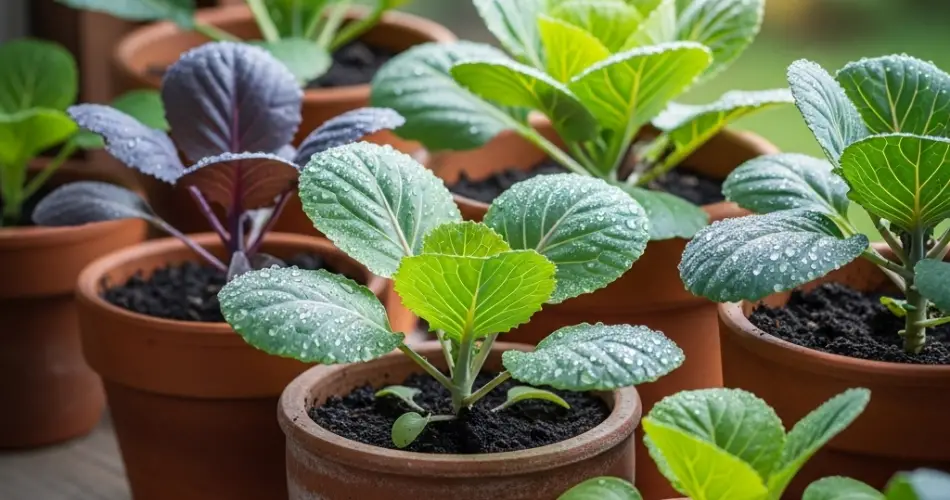Growing cabbage in containers is a practical solution for gardeners with limited space. Whether you’re working with a balcony, patio, or rooftop, pots make it possible to harvest large, leafy cabbages right at home. With the right soil mix, proper care, and attention to spacing, your container-grown cabbage can thrive and produce heads just as impressive as those grown in traditional garden beds.
Why Grow Cabbage in Pots?
Container gardening offers several benefits, especially for cabbage, which prefers cooler temperatures and rich soil. Pots allow you to:
-
Control soil quality and drainage
-
Move plants for optimal sunlight
-
Avoid common soil-borne pests and diseases
-
Extend the growing season by moving pots indoors or to shade
Even small spaces can yield big results when you grow cabbage in containers with thoughtful planning.
Best Varieties for Containers
While most cabbage types can grow in pots, some are better suited for compact spaces. Look for varieties that are:
-
Compact or mini-head types
-
Fast-maturing, to avoid issues with pests or heat
-
Well-suited for your climate zone
Popular container-friendly varieties include:
-
‘Golden Acre’ – early and compact
-
‘Dynamo’ – small but dense heads
-
‘Pixie’ – great for tight spaces and small containers
-
‘Savoy’ types – for their tender, crinkly leaves
Choose varieties based on your preference for green, red, or Savoy cabbage.
Choosing the Right Container
Cabbage develops a deep, broad root system and requires space to form large heads. Ideal pots for cabbage should be:
-
At least 12–14 inches deep
-
12–18 inches wide per plant
-
Made from plastic, ceramic, clay, or fabric grow bags
-
Equipped with good drainage holes
For multiple plants, use large planters or rectangular containers, spacing each plant at least 12–16 inches apart to allow for full head development.
Soil Preparation and Fertilization
Cabbage needs rich, fertile soil that holds moisture but drains well. Prepare a soil mix that includes:
-
High-quality potting mix
-
A generous amount of compost or aged manure
-
Perlite or vermiculite for aeration
Before planting, mix in a slow-release organic fertilizer high in nitrogen to support leafy growth. As the plant matures, switch to a balanced or phosphorus-rich fertilizer to promote head formation. You can also supplement every 2–3 weeks with a diluted liquid feed.
Planting Your Cabbage
You can start cabbage from seeds or transplant young seedlings. For container growing:
-
Direct sow seeds ¼ inch deep, or plant transplants with the base just above the soil line.
-
If sowing seeds, thin out to one healthy seedling per container or per 12–16 inches in larger pots.
-
Press the soil gently around the base and water well.
Keep the soil moist and avoid disturbing the roots during transplanting to prevent shock.
Light and Temperature Needs
Cabbage grows best in full sun (6–8 hours daily), though in very hot climates, some afternoon shade helps prevent bolting. Ideal temperature range:
-
Cool season crop: 15–24°C (60–75°F)
-
Cabbage can tolerate light frost but suffers in extreme heat
If temperatures soar, move pots to a cooler location or use shade cloth to protect the leaves.
Watering and Mulching
Cabbage needs consistent moisture, especially during head development. Follow these watering tips:
-
Water deeply when the top inch of soil is dry
-
Avoid waterlogging—good drainage is essential
-
Mulch with straw, dried leaves, or grass clippings to retain moisture and suppress weeds
Uneven watering may lead to cracked heads or stunted growth, so aim for consistency.
Common Pests and How to Manage Them
Container-grown cabbage can still be affected by pests such as:
-
Cabbage loopers and worms
-
Aphids and whiteflies
-
Flea beetles
Inspect plants regularly and use natural controls such as:
-
Neem oil or insecticidal soap
-
Row covers to block moths
-
Handpicking pests off leaves
-
Companion planting with herbs like dill or thyme to deter insects
Slugs can also be an issue—try placing crushed eggshells or diatomaceous earth around the base.
Harvesting Cabbage from Containers
Cabbage is ready to harvest when the head feels firm and full. Most varieties take 70–90 days from transplant to maturity. To harvest:
-
Use a sharp knife to cut the head at the base
-
Leave the outer leaves and stem in place—some varieties will grow smaller side shoots for a second harvest
Store harvested cabbage in a cool, dry place or refrigerate for up to a few weeks.
Tips for a Healthy Crop
-
Rotate crops in containers to avoid nutrient depletion and disease buildup.
-
Don’t plant cabbage with other brassicas (like broccoli or cauliflower) in the same soil year after year.
-
Add compost or fresh soil mix between plantings.
-
Keep containers slightly elevated for better air circulation and to prevent pests from crawling in.
Conclusion
Growing cabbage in pots is a rewarding way to enjoy fresh, homegrown vegetables without a traditional garden. With careful attention to variety selection, soil quality, watering, and pest control, your container cabbages can grow big and healthy, producing crisp, nutritious leaves for cooking and salads. Whether on a city balcony or a sunny porch, you can cultivate a thriving cabbage patch in pots with just a little effort and planning.



